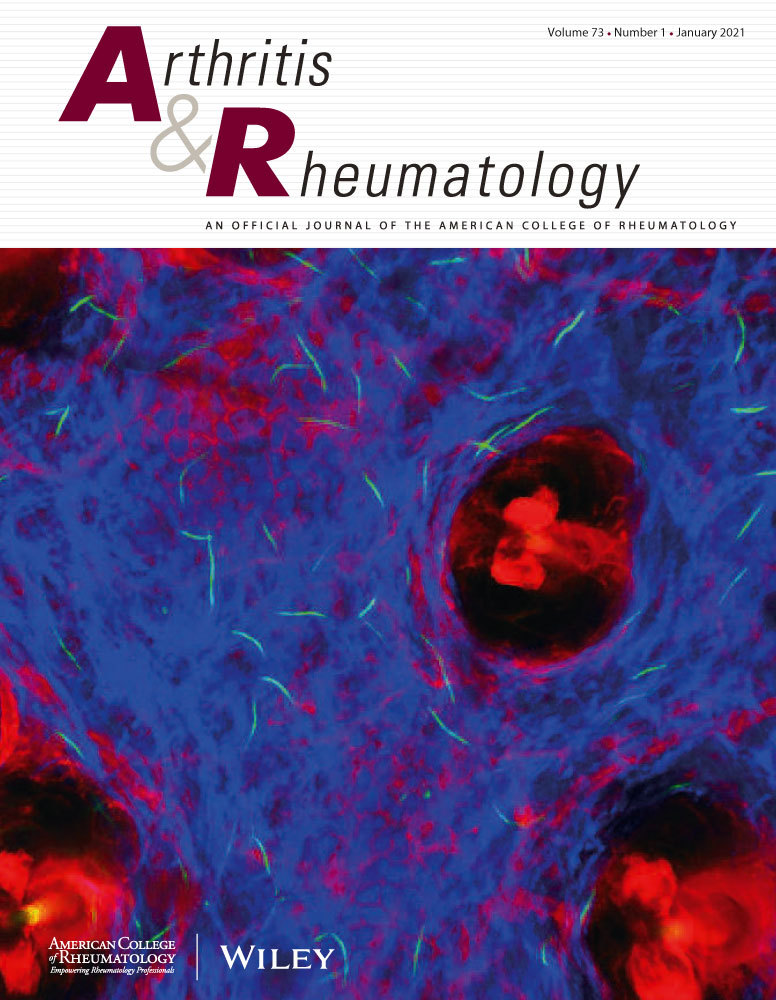银屑病关节炎的家族聚集性:有和无银屑病家族史患者的表型差异
IF 10.9
1区 医学
Q1 RHEUMATOLOGY
引用次数: 0
摘要
虽然高达45%的银屑病关节炎(PsA)患者有银屑病家族史,但目前尚不清楚这种家族史是否会导致独特的PsA表型和/或疾病发病时间。我们的目的是根据银屑病的家族史确定发病、结构域参与和疾病活动性的差异。方法843例PsA患者入组观察性纵向登记。收集人口统计学、病史、家族史、银屑病表型和活动性。结果379例(45.0%)患者至少有一个一级(FDR)或二级亲属(SDR)伴银屑病。有家族史的患者比无家族史的患者更早出现银屑病和PsA(27.6年vs. 32.2年,p <;0.01;37.6 vs. 40.3, p <;0.01),并且更有可能发生最终受累(36.7% vs. 30.0%, p <;0.05)。伴有PsA的FDR/SDR患者诊断为银屑病和PsA的时间早于单纯伴有银屑病的FDR/SDR患者,其次是无家族史的患者(26.3年vs. 27.8年vs. 32.2年,p <;0.01;36.5岁、37.9岁、40.3岁,p = 0.01)。结论:与无银屑病家族史的PsA患者相比,有银屑病家族史的PsA患者更早被诊断为银屑病和PsA,并且更容易累及皮肤。需要进一步的研究结合分子和免疫特征来研究影响PsA表型和严重程度的遗传、环境和表观遗传因素,以及牛皮癣向PsA的转变。本文章由计算机程序翻译,如有差异,请以英文原文为准。
Familial Aggregation in Psoriatic Arthritis: Phenotypic Differences in Patients with and without a Family History of Psoriatic Disease
ObjectivesWhile up to 45% of patients with psoriatic arthritis (PsA) have a family history of psoriatic disease, it is unclear whether this family history contributes to a distinct PsA phenotype and/or timing of disease onset. We aimed to identify differences in onset, domain involvement, and disease activity based on family history of psoriatic disease.Methods843 PsA patients were enrolled in an observational, longitudinal registry. Demographics, medical history, family history, and psoriatic phenotype and activity were collected.Results379 patients (45.0%) had at least one first‐degree (FDR) or second‐degree relative (SDR) with psoriatic disease. Those with a family history developed psoriasis and PsA earlier than those with no family history (27.6 vs. 32.2 years, p < 0.01; 37.6 vs. 40.3, p < 0.01) and were more likely to have entheseal involvement (36.7% vs. 30.0%, p < 0.05). Patients with an FDR/SDR with PsA were diagnosed with psoriasis and PsA earlier than those with an FDR/SDR with psoriasis alone, followed by those with no family history (26.3 vs. 27.8 vs. 32.2 years, p < 0.01; 36.5 vs. 37.9 vs. 40.3 years, p = 0.01).ConclusionIn this cohort, PsA patients with a family history of psoriatic disease were diagnosed with psoriasis and PsA earlier, and were more likely to have entheseal involvement, compared to those without a family history. Further research incorporating molecular and immune features is needed to investigate genetic, environmental and epigenetic factors that impact PsA phenotype and severity, as well as the transition from psoriasis to PsA.
求助全文
通过发布文献求助,成功后即可免费获取论文全文。
去求助
来源期刊

Arthritis & Rheumatology
RHEUMATOLOGY-
CiteScore
20.90
自引率
3.00%
发文量
371
期刊介绍:
Arthritis & Rheumatology is the official journal of the American College of Rheumatology and focuses on the natural history, pathophysiology, treatment, and outcome of rheumatic diseases. It is a peer-reviewed publication that aims to provide the highest quality basic and clinical research in this field. The journal covers a wide range of investigative areas and also includes review articles, editorials, and educational material for researchers and clinicians. Being recognized as a leading research journal in rheumatology, Arthritis & Rheumatology serves the global community of rheumatology investigators and clinicians.
 求助内容:
求助内容: 应助结果提醒方式:
应助结果提醒方式:


